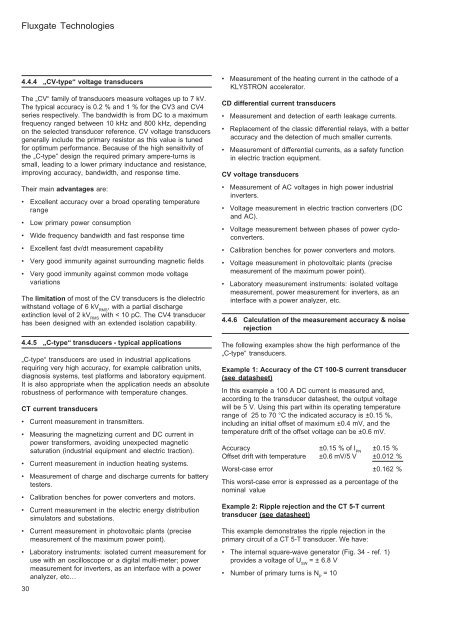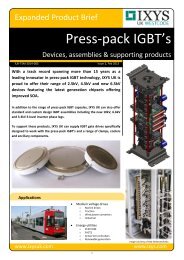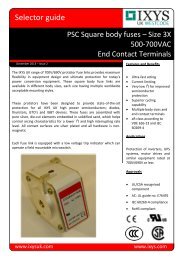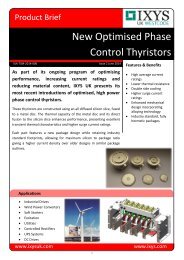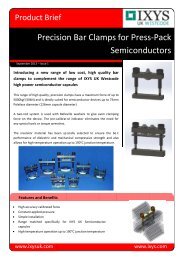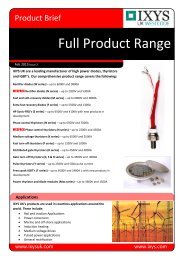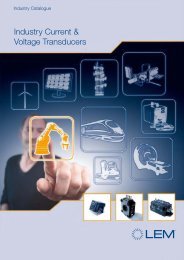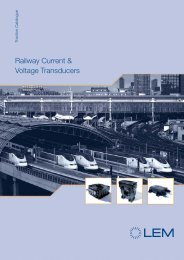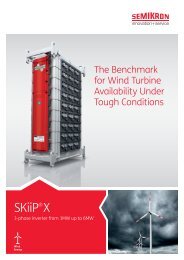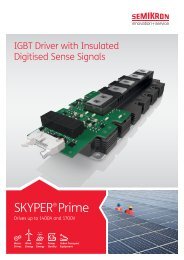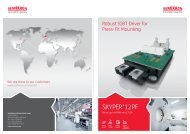isolated current voltage transducers
Create successful ePaper yourself
Turn your PDF publications into a flip-book with our unique Google optimized e-Paper software.
Fluxgate Technologies<br />
4.4.4 „CV-type“ <strong>voltage</strong> <strong>transducers</strong><br />
The „CV“ family of <strong>transducers</strong> measure <strong>voltage</strong>s up to 7 kV.<br />
The typical accuracy is 0.2 % and 1 % for the CV3 and CV4<br />
series respectively. The bandwidth is from DC to a maximum<br />
frequency ranged between 10 kHz and 800 kHz, depending<br />
on the selected transducer reference. CV <strong>voltage</strong> <strong>transducers</strong><br />
generally include the primary resistor as this value is tuned<br />
for optimum performance. Because of the high sensitivity of<br />
the „C-type“ design the required primary ampere-turns is<br />
small, leading to a lower primary inductance and resistance,<br />
improving accuracy, bandwidth, and response time.<br />
Their main advantages are:<br />
• Excellent accuracy over a broad operating temperature<br />
range<br />
• Low primary power consumption<br />
• Wide frequency bandwidth and fast response time<br />
• Excellent fast dv/dt measurement capability<br />
• Very good immunity against surrounding magnetic fields<br />
• Very good immunity against common mode <strong>voltage</strong><br />
variations<br />
The limitation of most of the CV <strong>transducers</strong> is the dielectric<br />
withstand <strong>voltage</strong> of 6 kV RMS<br />
, with a partial discharge<br />
extinction level of 2 kV RMS<br />
with < 10 pC. The CV4 transducer<br />
has been designed with an extended isolation capability.<br />
4.4.5 „C-type“ <strong>transducers</strong> - typical applications<br />
„C-type“ <strong>transducers</strong> are used in industrial applications<br />
requiring very high accuracy, for example calibration units,<br />
diagnosis systems, test platforms and laboratory equipment.<br />
It is also appropriate when the application needs an absolute<br />
robustness of performance with temperature changes.<br />
CT <strong>current</strong> <strong>transducers</strong><br />
• Current measurement in transmitters.<br />
• Measuring the magnetizing <strong>current</strong> and DC <strong>current</strong> in<br />
power transformers, avoiding unexpected magnetic<br />
saturation (industrial equipment and electric traction).<br />
• Current measurement in induction heating systems.<br />
• Measurement of charge and discharge <strong>current</strong>s for battery<br />
testers.<br />
• Calibration benches for power converters and motors.<br />
• Current measurement in the electric energy distribution<br />
simulators and substations.<br />
• Current measurement in photovoltaic plants (precise<br />
measurement of the maximum power point).<br />
• Laboratory instruments: <strong>isolated</strong> <strong>current</strong> measurement for<br />
use with an oscilloscope or a digital multi-meter; power<br />
measurement for inverters, as an interface with a power<br />
analyzer, etc…<br />
30<br />
• Measurement of the heating <strong>current</strong> in the cathode of a<br />
KLYSTRON accelerator.<br />
CD differential <strong>current</strong> <strong>transducers</strong><br />
• Measurement and detection of earth leakage <strong>current</strong>s.<br />
• Replacement of the classic differential relays, with a better<br />
accuracy and the detection of much smaller <strong>current</strong>s.<br />
• Measurement of differential <strong>current</strong>s, as a safety function<br />
in electric traction equipment.<br />
CV <strong>voltage</strong> <strong>transducers</strong><br />
• Measurement of AC <strong>voltage</strong>s in high power industrial<br />
inverters.<br />
• Voltage measurement in electric traction converters (DC<br />
and AC).<br />
• Voltage measurement between phases of power cycloconverters.<br />
• Calibration benches for power converters and motors.<br />
• Voltage measurement in photovoltaic plants (precise<br />
measurement of the maximum power point).<br />
• Laboratory measurement instruments: <strong>isolated</strong> <strong>voltage</strong><br />
measurement, power measurement for inverters, as an<br />
interface with a power analyzer, etc.<br />
4.4.6 Calculation of the measurement accuracy & noise<br />
rejection<br />
The following examples show the high performance of the<br />
„C-type“ <strong>transducers</strong>.<br />
Example 1: Accuracy of the CT 100-S <strong>current</strong> transducer<br />
(see datasheet)<br />
In this example a 100 A DC <strong>current</strong> is measured and,<br />
according to the transducer datasheet, the output <strong>voltage</strong><br />
will be 5 V. Using this part within its operating temperature<br />
range of 25 to 70 °C the indicated accuracy is ±0.15 %,<br />
including an initial offset of maximum ±0.4 mV, and the<br />
temperature drift of the offset <strong>voltage</strong> can be ±0.6 mV.<br />
Accuracy ±0.15 % of I PN<br />
±0.15 %<br />
Offset drift with temperature ±0.6 mV/5 V ±0.012 %<br />
Worst-case error ±0.162 %<br />
This worst-case error is expressed as a percentage of the<br />
nominal value<br />
Example 2: Ripple rejection and the CT 5-T <strong>current</strong><br />
transducer (see datasheet)<br />
This example demonstrates the ripple rejection in the<br />
primary circuit of a CT 5-T transducer. We have:<br />
• The internal square-wave generator (Fig. 34 - ref. 1)<br />
provides a <strong>voltage</strong> of U SW<br />
= ± 6.8 V<br />
• Number of primary turns is N P<br />
= 10


